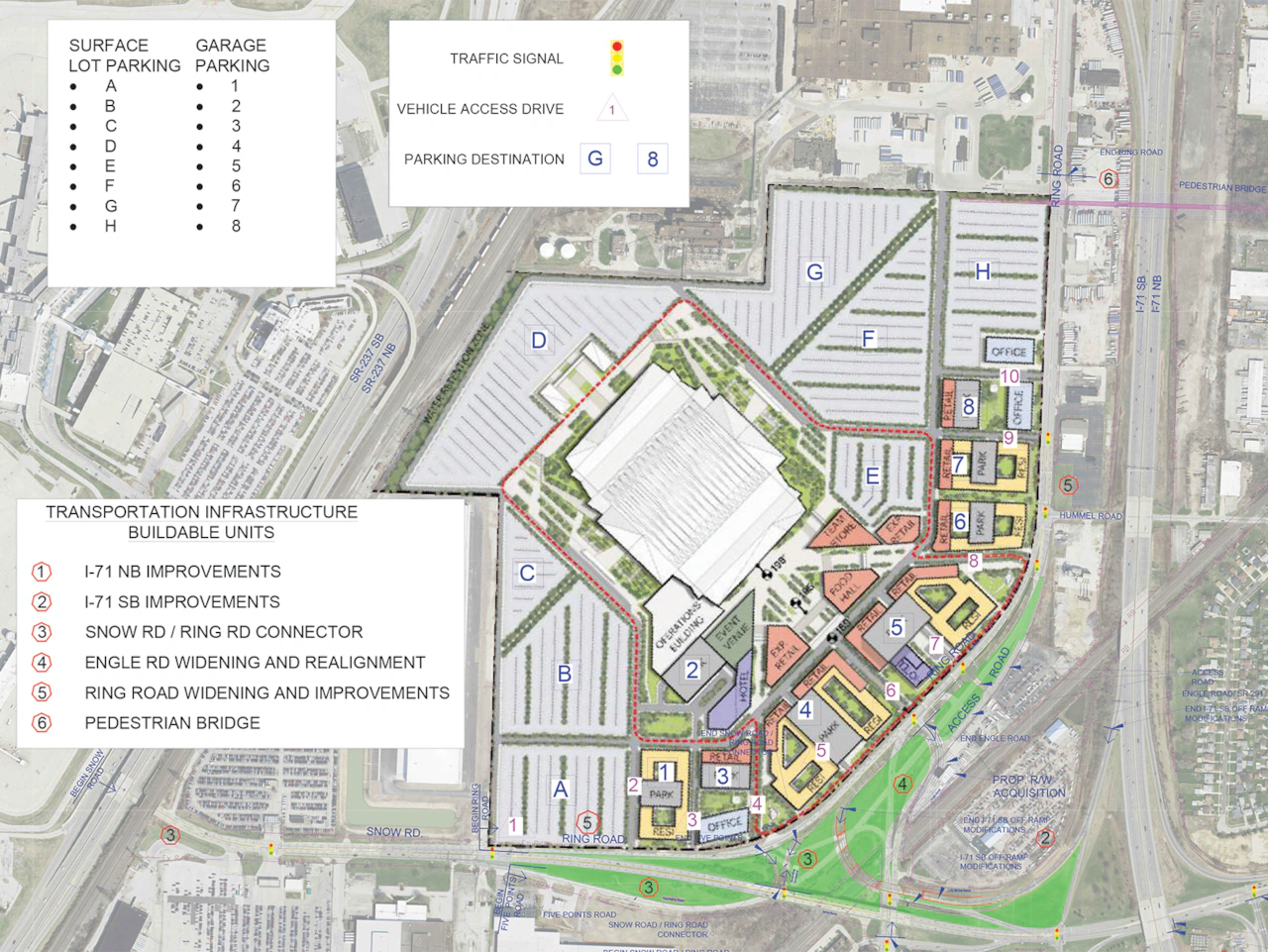
NEW PHILADELPHIA, Ohio — Brook Park Mayor Edward Orcutt and the Cleveland Browns on Wednesday pitched their request to state officials for $70 million to help pay for road and pedestrian improvements, saying they are on a tight timeline to complete the work in time for the opening of the stadium in 2029.
Yet, they said because of the existing highways, such as Interstate 71, and the local infrastructure that was built up to accommodate what once were 16,000 Ford Motor Co. workers at the site, the needs were “relatively modest” for a project of its scope.
The proposed improvements include upgrades to the I-71/Snow Road interchange, construction of a ring road around the stadium site, a bridge over railroad tracks, and a pedestrian bridge over Engle Road. The Browns are covering roughly $11 million in pre-construction engineering work. Not included in this proposal is the separate discussion of a $40 million light rail station.
Their presentation came during a regional meeting of the Transportation Review Advisory Council, often referred to as TRAC, which is responsible for deciding how to allocate money for major road improvements.
The application was submitted in June by the city of Brook Park. A spokesperson for the Ohio Department of Transportation said no decision would be made until next year.
Related coverage of stadium plans
Cleveland renews fight over height of proposed Browns Brook Park stadium near the airport
Revised Browns traffic plan goes to NOACA with add of $40M rail station; more study may be required
Bulldozers roll as Browns gear up for Brook Park stadium construction (photo gallery)
Browns announce AECOM Hunt, Turner Construction to build Brook Park stadium
This report on airport safety was key to saving Browns’ new Brook Park stadium plans
Separately, a five-county planning organization – the Northeast Ohio Areawide Coordinating Agency – is contemplating requiring an extensive multi-city traffic study before signing off on the work. Major highway changes need NOACA approval.
The $3.4 billion project — $2.4 billion for the stadium and another $1 billion for surrounding development over 178 acres — is being described as one of the largest economic development projects in Ohio history.
The infrastructure improvements are above and beyond the $3.4 billion estimate.
Mayor Orcutt outlined Brook Park’s history as a manufacturing hub, noting the loss of thousands of jobs to 1,600 today – punctuated with the demolition of two plants about 15 years ago.
“With this project, we have a chance to bring new jobs and new life to that property,” Orcutt said.
Ted Tywang, chief administrative officer and general counsel for the Haslam Sports Group and the Browns, told the committee the project would mostly be privately funded.
He said the financing plan for the stadium includes $600 million already approved by the state and $300 million in Brook Park taxes, drawn from new tax revenues generated by the development. The team would cover the rest – $1.5 billion, plus any cost overruns.
This is different than originally proposed. The Browns, when rolling out their plans publicly in February, said they would cover $1.2 billion, asking for $600 million from city and county taxes, and $600 million from the state.
However, Cuyahoga County Executive Chris Ronayne strongly opposed that idea, triggering the Browns to say they would move forward without the county’s involvement if necessary.
Tywang told the TRAC committee that the privately funded mixed-use portion of the project is expected to include two hotels, roughly 300,000 square feet of retail space, 1,200 residential units built in phases, and eventually some office development.
Excavation work began last week, officials said. The team has said it intends to begin construction of the stadium next year.
“We’re on a bit of a tight timeframe and that is driven by the expiration of our lease of the current stadium in 2028,” Tywang told the committee. “It has to be completed in 2029 for us to start playing football in the new stadium. But it’s not just the stadium that needs to be done in 2029. It’s phase one of the development. It’s the enabling infrastructure.
“So everything is working toward that timeframe. We have engaged heavily with NOACA and dozens of other local stakeholders. I appreciate the comments of NOACA (requesting additional information) just before our presentation. We hope that it will be on the long-range (NOACA) plan soon as we work through that process.”
The TRAC committee didn’t ask any questions before moving on to other projects on the agenda.
A NOACA committee is to discuss the stadium’s transportation plans on Friday.
Meanwhile, the city of Cleveland has both filed a suit in an attempt to block the team’s move from the city-owned stadium to the suburb and filed notice that it will appeal ODOT’s permit issued over the city’s objection to the proposed height of stadium near the airport.